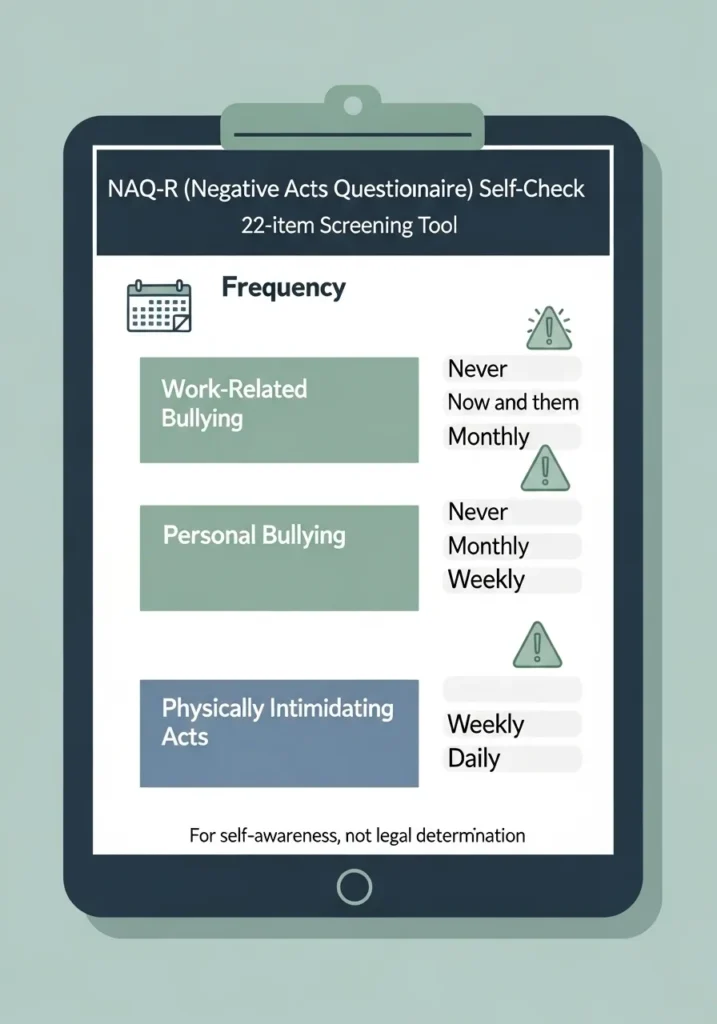Workplace Bullying: How to Identify, Document, and Take Action

What Is Workplace Bullying?
Workplace bullying affects millions of Americans—WBI’s national survey estimates 32.3% of adults have been directly bullied. If you feel targeted, excluded, or undermined at work, you are not imagining it. This article explains what workplace bullying is, how it differs from unlawful harassment, and what steps you can take to protect yourself. In this post, we’ll explore clear definitions, common behaviors, the research‑validated NAQ‑R self‑check, and how WorkplaceWitness.ai helps you document bullying at work and build a strong, factual record.

What is workplace bullying?
Workplace bullying is repeated, health‑harming mistreatment that humiliates, undermines, or intimidates a worker. It shows up as patterns: public put‑downs, information withholding, sabotage, or social exclusion that erodes your well‑being and performance. Agencies group bullying with “psychosocial hazards” because it harms both mental and physical health.
Bullying vs. unlawful harassment: In the U.S., conduct becomes illegal harassment when it is based on a protected characteristic (for example, race, sex—including sexual orientation and gender identity—religion, national origin, age 40+, disability, or genetic information) and it is severe or pervasive enough to create a hostile or abusive environment, or it results in a negative job action. Bullying that isn’t tied to a protected trait can still violate policy, but may not violate federal law. Therefore, identifying motive and documenting impact are crucial.
Recognizing bullying at work: behaviors and examples
Patterns help you spot bullying at work. Look for ongoing behaviors such as:
- Verbal abuse or ridicule: Shouting, insults, or public humiliation.
- Work sabotage: Withholding key information or moving goalposts.
- Exclusion: Leaving you off emails, meetings, or projects on purpose.
- Micromanagement: Constant criticism with impossible standards.
- Threats or intimidation: Menacing gestures or veiled threats.
- Cyberbullying: Demeaning messages or pile‑ons in chat or email.
Why this matters: Bullying creates a hostile environment in the everyday sense. However, it is unlawful only when tied to protected traits and severe or pervasive. Because lines can blur, precise records of who, what, when, where, and impact help clarify what you are facing and what remedies apply.
Related reading:
• Red Flags at Work: 10 Early Warning Signs of a Hostile Work Environment — practical examples and early cues to watch.
• Hostile Work Environment: Understanding It and Documenting It — legal context and documentation steps.
Use a quick self‑check: the NAQ‑R (Negative Acts Questionnaire‑Revised)
The NAQ‑R is a research‑validated, 22‑item questionnaire that measures exposure to bullying behaviors. It asks how often specific “negative acts” occurred over the last six months (Never, Now and then, Monthly, Weekly, Daily). The items cluster into work‑related bullying, personal bullying, and physically intimidating acts. You can review the items to see whether a repeated pattern is present. Note: It’s a screening tool, not a legal finding.
How to use it wisely: Complete the NAQ‑R privately, then compare your scores over time. If your frequency rises, you likely face a persistent pattern rather than isolated tension. You can also share these results with your therapist or attorney — we do not recommend sharing anything with HR. Because self‑checks spark clarity, they pair well with incident logs and evidence.
Want to try the NAQ-R now? It’s only 22 questions! Check it out here.

Why documentation matters (and how to do it right)
Timely, detailed documentation is your best protection. It preserves facts, reveals patterns, and reduces self‑doubt when you raise concerns.
What to capture each time:
- Date, time, and location of the incident.
- People involved and any witnesses.
- Exactly what happened, including direct quotes.
- Impact on your work, health, or opportunities.
- Evidence such as emails, chats, screenshots, or photos.
A note on recordings: U.S. state laws vary. Many states allow one‑party consent, while some require all‑party consent. Before recording, check the law in your state (or ask a lawyer). When in doubt, focus on written evidence and prompt, factual notes.
Health and safety angle: Bullying and workplace violence exist on a continuum. Even non‑physical abuse can harm health. NIOSH and OSHA highlight the serious, long‑term psychological and physical effects of workplace violence and emphasize prevention policies and training.
How WorkplaceWitness.ai helps you document bullying in the workplace
WorkplaceWitness.ai is built for employees—never for employers—and keeps your data under your control. The platform emphasizes privacy and documentation quality so you can act with confidence.
- Guided incident & pattern logging: Structured prompts help you capture the who/what/when/where the same way every time.
- Evidence organization: Store emails, messages, images, and witness details securely in one place.
- Timeline & pattern builder: Generate a chronological view to show frequency and escalation.
- Professional, legal‑ready reports and secure sharing: Export time‑stamped summaries for HR or an attorney and share only when you decide.
- Security & privacy: The site stresses end‑to‑end encryption and user‑controlled access—your employer does not get access unless you share.
- eDiscovery‑friendly exports: Structured, portable files preserve metadata and chain‑of‑custody elements for legal workflows.
Related reading: The Hidden Scars: Confronting the Deep Mental Toll of Workplace Abuse — understanding the personal impact while you build your record.
Is it bullying, illegal harassment, or both?
Start with motive and effect. If conduct targets a protected characteristic and is severe or pervasive, it may be unlawful harassment under federal civil rights laws. If it is not tied to a protected trait but still repeated and harmful, it is bullying and often a policy violation. In both cases, documentation and timely reporting matter.
Where to go next: Many employers prohibit bullying and abusive conduct in their codes of conduct. But, it may not always be safe to report to HR, as often times, companies don’t enforce those policies equally. Therefore, we always reccomend talking to a qualified employment attorney or other qualified individual about your unique case about next steps. If the behavior involves protected traits or you fear retaliation, consult an employment attorney or consider contacting the EEOC or your state agency.
Taking action: a step‑by‑step plan
1) Document now. Start your log with the next incident while details are fresh. Add evidence as you go. WorkplaceWitness.AI
2) Review your score. Use the NAQ‑R to check patterns and severity over time. Then note changes in frequency.
3) Set boundaries (if safe). Briefly name the behavior and request a change: “Please send feedback in writing. I need clear deadlines.”
4) Use policy channels. Report facts, not interpretations. Provide dates, quotes, and attachments.
5) Escalate as needed. If the conduct involves protected traits or if your report goes nowhere, seek legal guidance, connect with an attorney using WorkplaceWitness, or contact the EEOC.
6) Care for your health. Chronic exposure to abusive conduct can harm mental and physical health. Consider professional support.
Related reading: Witnessed Workplace Discrimination? A Guide to Being an Effective Ally — How Coworkers Can Support You.
FAQs about bullying in the workplace
Is bullying at work illegal?
It can be, when it’s harassment based on a protected trait and severe or pervasive. Otherwise, it may violate policy without violating federal law. Document the pattern and check your options.
How common is workplace bullying?
The 2024 WBI U.S. Workplace Bullying Survey reports 32.3% of adult Americans have been directly bullied. That’s why early recognition and documentation matter.
Should I record conversations?
Only if it’s legal in your state and safe to do so. Many states allow one‑party consent; several require all‑party consent. Check a current 50‑state guide or consult a lawyer.
What if HR ignores my complaint?
We never suggest talking to HR until you speak with an attorney or other qualified individual about appropriate steps. Keep documenting. Follow up in writing. If protected traits or retaliation are involved, talk to an employment attorney or contact the EEOC.
Need an attorney? The National Employment Lawyers Association (NELA) has a directory! Try and find one local to you.
Conclusion: Your record is your power
You do not have to second‑guess yourself. If repeated behaviors make you dread work, it is reasonable to evaluate them as possible workplace bullying. Now you know the signs, the legal line between bullying and harassment, how to self‑check with the NAQ‑R, and how WorkplaceWitness.ai helps you build a clear, private record so you can act with confidence.
Stay Updated
Get the latest updates about workplace rights and our app launch.